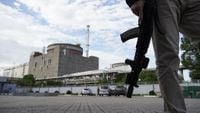For six tense days in late September 2025, the Zaporizhzhia Nuclear Power Plant—the largest in Europe—has been plunged into a record-breaking blackout, running solely on emergency diesel generators and stoking fears of a nuclear disaster that could reverberate far beyond Ukraine’s borders. The plant, located in southeastern Ukraine and under Russian occupation since March 2022, lost its critical connection to Ukraine’s electricity grid on September 23, following reported Russian shelling that damaged the last operational transmission line.
As reported by Reuters and echoed by multiple sources, Rafael Grossi, the director general of the International Atomic Energy Agency (IAEA), confirmed on September 29 that the plant had been without offsite power for six days. Grossi, in a post on X, described meeting with Ukrainian Foreign Minister Andrii Sybiha in Warsaw to discuss the deepening crisis, stating that the IAEA was working to facilitate the restoration of power. "The world cannot allow this," Sybiha wrote, emphasizing the urgent need for international intervention as Russia, in his words, had "stolen the Ukrainian nuclear power plant and is trying to forcibly integrate it into its grid despite the growing risk of a nuclear incident."
Energoatom, Ukraine’s state nuclear company, warned that the situation is critical. The plant’s backup diesel generators—designed only for emergency use—cannot sustain operations indefinitely. "This creates a critical situation that threatens the security of not only Ukraine but also European countries," Energoatom cautioned in a statement shared by the Kyiv Independent. Shaun Burnie, a nuclear energy expert at Greenpeace Ukraine, described the 120-hour (five-day) disconnection as "the longest by far loss of power to the plant since the criminal Russian attack and occupation in 2022." He added, "There is no justification for Russian engineers to fail to repair the damage to the grid line, and this must be done immediately."
The blackout, the tenth such incident since the start of Russia’s full-scale invasion in 2022, has forced the plant to rely entirely on these diesel generators to cool reactor cores and spent fuel pools—an arrangement fraught with risk. European nuclear regulations, introduced after the Fukushima disaster in 2011, showed that nuclear plants are generally designed to withstand a loss of external power for up to 72 hours; beyond that, the consequences become unpredictable and potentially catastrophic. Until now, operation beyond that threshold had remained untested.
Oleh Korikov, head of Ukraine’s State Nuclear Regulatory Inspectorate, did not mince words in his assessment. He called the lack of external power "a major threat to nuclear and radiation safety" and urged swift restoration. "Ignoring the requirements and principles of nuclear and radiation safety, the shelling of power transmission lines by Russian forces and their damage, as well as creating obstacles for Ukrainian specialists to restore these lines—all these actions could lead to the worst-case scenario," Korikov warned, as reported by RBC Ukraine. He further stressed the uncertainty surrounding the plant’s remaining diesel reserves, saying, "It is currently unknown what reserves of diesel fuel remain at the plant site and how long the diesel generators can continue to operate to power the safety systems and other systems vital to the plant's safety."
The primary concern, according to Korikov, is maintaining the cooling systems for spent nuclear fuel stored in all six reactors and spent fuel pools. Should the diesel run out before external power is restored, the risk of a nuclear accident—potentially on the scale of Fukushima—would rise sharply, with radiological consequences not only for Ukraine but for much of Europe.
The plant’s strategic significance has made it a flashpoint throughout the conflict, with both Moscow and Kyiv accusing each other of shelling the area and endangering nuclear safety. Since Russian troops seized the facility in the early weeks of the war, Ukraine has repeatedly called for the withdrawal of Russian forces and the establishment of a demilitarized zone around the plant, a proposal Russia has consistently rejected. The IAEA has maintained a monitoring mission at the site since September 2022, but Russian authorities have frequently restricted its access, further complicating oversight and crisis management.
Adding to the mounting concerns, research published by Truth Hounds and Greenpeace Ukraine on September 24 alleged that Russia’s state nuclear agency, Rosatom, has been complicit in war crimes at the plant, including the detention and torture of staff. These allegations, if substantiated, would represent a grave escalation in the risks associated with the plant’s continued occupation and operation under Russian control.
Burnie, the Greenpeace expert, was unequivocal in his assessment of the current threat. “The Russian attempt to reconnect the ZNPP may be the worst yet, posing the greatest risks. Moscow is actively attempting to enlist the IAEA in this adventure and justify its theft of the ZNPP,” he said, according to the Kyiv Independent. He further argued that “Grossi must insist to Russia that no restart is possible of any reactor under the condition of illegal Russian occupation, and the nuclear plant must be de-occupied from Russian armed forces and Rosatom, and returned to Ukraine.”
Meanwhile, Russia maintains that the facility has sufficient diesel reserves to continue running the generators, a claim met with skepticism by Ukrainian officials and international observers alike. The ongoing standoff has left the plant’s fate—and the safety of millions—hanging in the balance.
In the face of these mounting dangers, Ukrainian officials have proposed granting temporary stewardship of the plant to the IAEA as “the only realistic option,” according to Sybiha. This proposal, if enacted, could provide a neutral mechanism for restoring safety and preventing further escalation, though its prospects remain uncertain amid ongoing hostilities and entrenched positions on both sides.
As the blackout drags on and the world watches anxiously, the Zaporizhzhia crisis serves as a stark reminder of the enduring risks of war in a nuclear age—and the urgent need for international cooperation to prevent disaster from striking at the heart of Europe.





